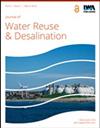用于去除污染河流水中重金属的低成本聚乙烯
IF 2.3
Q2 Environmental Science
引用次数: 0
摘要
饮用水中的重金属污染是一种严重的健康风险,特别是在发展中国家。合成了聚乙烯醇甲醛(PFA)膜,探讨了其在墨西哥受污染的阿托亚克河水样中重金属去除的应用。根据墨西哥标准,用PFA膜孵育24小时就足以将铅、铁、锰、砷和铊的浓度降低到饮用水可接受的水平。PFA具有较高的吸附能力(Qe),即使在多种金属存在和低阳离子浓度的情况下也是如此。质量传递现象表征为交联度和ph的函数。为了模拟实际操作条件,通过PFA膜的水通量表征为其交联度和受控外部压力的函数。PFA膜允许通量在高达2千克/平方厘米的压力下不变形或破裂。拉伸强度,应变应力,弹性变形和杨氏模量进行了评估。与之前的报道相比,不需要进一步的PFA改性就可以获得优异的吸附性能,从而降低了生产成本。PFA易于合成和处理,生产成本低,是修复城市污水的理想材料。本文章由计算机程序翻译,如有差异,请以英文原文为准。
Low-cost poly(vinyl formal) for heavy metal removal from water of a polluted river
Heavy metal pollution in drinking water is a serious health risk, particularly in developing countries. Membranes of poly(vinyl formal) (PFA) were synthesized to explore their use for heavy metal removal from water samples from the polluted Mexican river ‘Atoyac.’ A single incubation step with PFA membranes for 24 h was sufficient to reduce lead, iron, manganese, arsenic, and thallium concentrations to acceptable levels for drinking water, according to the Mexican standards. PFA showed high adsorption capacities (Qe), even in the presence of multiple metals and low cation concentration. Mass transport phenomena were characterized as a function of the crosslinking degree and pH. To simulate real-life operation conditions, water fluxes across PFA membranes were characterized as a function of their crosslinking degrees and controlled external pressures. PFA membranes allowed fluxes at pressures of up to 2 kg/cm2 with no deformation or breaking. Tensile strength, strain stress, elastic deformation, and Young's modulus were assessed. In contrast with previous reports, no further PFA modifications were required to obtain an excellent adsorption performance, which results in lower production costs. The ease of PFA synthesis and handling, and low production cost make it an ideal material to be applied for remediating the polluted urban water.
求助全文
通过发布文献求助,成功后即可免费获取论文全文。
去求助
来源期刊

Journal of Water Reuse and Desalination
ENGINEERING, ENVIRONMENTAL-WATER RESOURCES
CiteScore
4.30
自引率
0.00%
发文量
23
审稿时长
16 weeks
期刊介绍:
Journal of Water Reuse and Desalination publishes refereed review articles, theoretical and experimental research papers, new findings and issues of unplanned and planned reuse. The journal welcomes contributions from developing and developed countries.
 求助内容:
求助内容: 应助结果提醒方式:
应助结果提醒方式:


